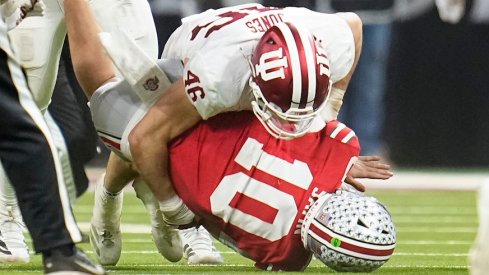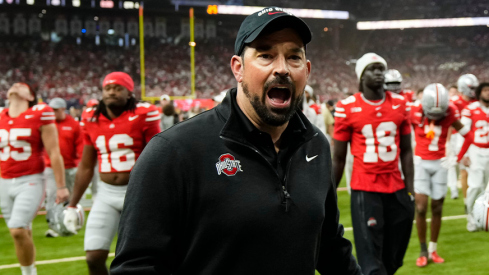
Against Northwestern the Ohio State defense turned in a performance that is somewhat emblematic of Luke Fickell and Everett Withers' era with the Buckeyes.
The Buckeye defense stopped the run, took away Northwestern's base option game and made crucial stops. Yet the Buckeyes' pass defense was porous, with coverage breakdowns and missed tackles yielding explosive plays that the Wildcats were able to turn into points.
Northwestern has a talented offense and it is unrealistic to expect Ohio State – or any defense – to completely shut Northwestern down. And the Buckeyes held the Wildcats to only one second half touchdown. Yet that touchdown was enabled by yet another coverage breakdown.
Perhaps more troubling, it is difficult to discern what the Buckeyes' overall defensive philosophy consists of, as play calls shift from game to game and series to series.
Below I discuss the Buckeyes' defensive strategy, coverage lapses, and the stirrings of a consistent pass rush that could significantly improve the Buckeye defense.
Pretty Standard Actually
The Buckeyes generally employed their base 4-2-5 nickel over defense against the Wildcats. The Buckeyes mixed playing quarter-quarter-half and cover 3 with using cover 1 man coverage, often behind blitzes, in an attempt to stop Northwestern's run game.
On third down the Buckeyes often used their 30 odd front dime look.
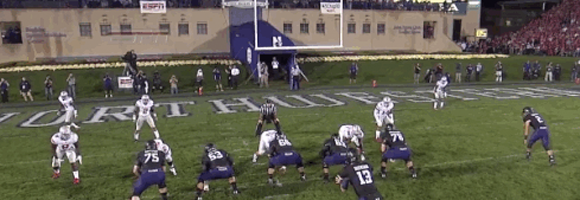
Here too the coaching staff mixed three man rushes and cover 3 with aggressive blitz schemes.
Jack of All Trades, Master of None
The Ohio State defense had breakdowns with each scheme. With a three man pass rush a defense coaching staff does not expect substantial pressure. But that should be made up for with tight windows , making it difficult for the quarterback to throw. But Ohio State's eight man zone all too often had gaping holes. Northwestern's first touchdown throw came against such a package. Ohio State played a three deep, five under coverage towards Northwestern's trips.

But Curtis Grant did not hit and re-route the receiver or get proper depth. The result was an easy seam throw before Corey Brown got back to the middle of the field.
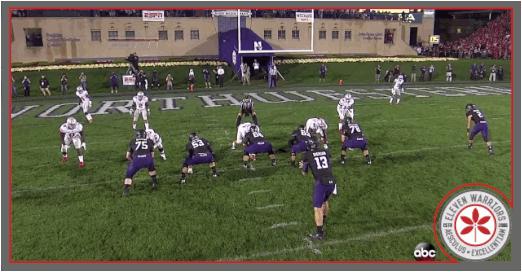
But the Buckeyes also yielded big plays bringing pressure with man coverage. Below Ohio State brought a six man blitz with cover 1 behind. The blitz did not get home and two poor angles by Bradley Roby and CJ Barnett later, Venrick Mark was racing down the sideline.

Same SONG Different Verse
In Good News...
But it was not all grim against the Wildcats. A week after Wisconsin the Buckeyes shut down another efficient, albeit different, run offense. The Buckeyes' front four controlled the line of scrimmage against Northwestern's inside zone read, preventing the Wildcats from getting to the second level. When Kain Colter sought to keep, the Buckeyes often had a linebacker and safety sitting on the quarterback, often with a backside scrape exchange.

Perhaps more importantly the Buckeyes shut down Northwestern's option game. This is where the Wildcats are most effective. Yet the Buckeyes eliminated the play. Ohio State's force support player, here Roby, forced Colter to quickly pitch.

Barnett then took an excellent pursuit angle to prevent any gain.

As against Wisconsin, the Buckeyes indubitably surrendered some pass yards in exchange for stopping the run, using a lot of single high safety coverage to provide an eighth defender in run support. In doing so, however, they took away Northwestern's preferred mode of attack.
With a Twist
Perhaps more importantly, the Ohio State defensive line exhibited a consistent four-man pass rush, particularly as the game progressed. The Buckeyes defensive coaching staff often ran a twist. The defensive end slants inside, with the defensive tackles looping around.
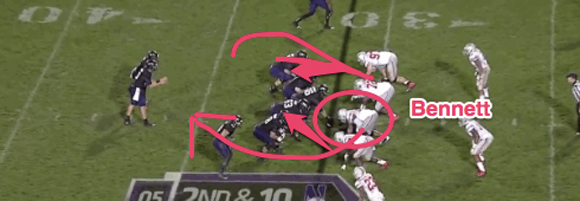
This takes advantage of the Buckeyes' best defensive linemen Michael Bennett, allowing him to use his quickness to beat the guard and tackle as they attempt to exchange blocks.

In addition to Bennett, the Buckeyes have four other defensive linemen who can consistently rush the passer in Adolphus Washington, Noah Spence, Joey Bosa, and Jamal Marcus. Bosa and Marcus were particularly impressive. Bosa displayed an increasingly adaptiveness as a rusher, using a strong first step and rip technique to record several sacks. Marcus is able to come in fresh in third down situations and use his quickness to get the offensive tackle off-balance.
The Ohio State defense was able to combine together solid run defense with a good pass rush to make several critical stops throughout the game, such as holding Northwestern to a field goal after the Buckeyes' failed fake punt, forcing a three and out after Braxton Miller's second fumble, and Doran Grant's critical interception.
So Where To?
The Buckeye defense thus continues to intersperse good play with breakdowns that permit explosive plays and points. It is too easy to throw one's hands up, however, and state it is an execution issue. Instead, the Buckeyes can emphasize their strengths to try and eliminate explosive plays.
Ohio State again demonstrated that when they pressure the quarterback they are able to eliminate easy throwing lanes and force mistakes. The last two weeks demonstrated that quarterbacks, particularly at the collegiate level, are far less effective when they have to make quick decisions in the face of pressure.
That is not to say that Ohio State needs to bring six man bltizes all the time. But it does mean that they should allow their defensive line to operate. Whatever the merits of a three man rush with eight person coverage as a general manner, it does not work well for this defense because there are still open receivers. Luke Fickell admitted as much yesterday.
The Buckeyes simply have too many poor zone pass defenders. For instance, Curtis Grant is such a liability in pass coverage that he should often be used as a blitzer. This problem is only exacerbated by the loss of Christian Bryant. Brown was too often lost in coverage, raising the issue as to whether he is the long term solution to replace Bryant.
Ohio State thus must rely upon their defensive line to pressure the quarterback to help their linebackers and safeties in coverage. This would also help the Buckeye defense establish an identity. All too often it seems as though Ohio State is veering from bringing 7 man pressures and playing man coverage one series to dropping eight the next. A defense must obviously keep an offense off-balance, but the Buckeyes need a framework to rely upon in passing situations. Building upon their defensive line to stop the run and pressure the quarterback is a good starting point. This alone will not eliminate explosive plays, but it is at least a building block.
